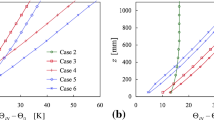Abstract
In an inversion-capped planetary boundary layer (PBL), the structure of the turbulent fluxes as well as the height of the inversion are determined by the interaction of turbulent mixing in the PBL, large-scale subsidence above the PBL and radiational cooling. Here the sensitivity of the inversion height and of the turbulent fluxes due to radiational processes is investigated with the aid of a three-layered model for a well mixed PBL. For an example of the Trade-Wind region, the inversion height (i.e., the difference between surface pressure and pressure at the inversion level) varies between 46 and 257 mb and the surface flux of moist static energy between 417 and 99 W m-2, if the (mean) radiative net flux divergence for both the inversion and the well-mixed layer is changed over a reasonable range of values. None of the parameterization schemes existing in the literature is able to describe these radiational effects in an appropriate way. This is due to the fact that these parameterizations are either not or not flexibly enough linked to the thermodynamical model parameter. Therefore the demand for an adequate parameterization of the radiational influence in a well-mixed PBL under a subsidence inversion is obvious.
Similar content being viewed by others
References
Albrecht, B. A., Betts, A. K., Schubert, W. H., and Cox, S. K.: 1979, ‘A model of the Thermodynamic Structure of the Trade-Wind Boundary Layer, Part I: Theoretical Formulation and Sensitivity Tests’, J. Atmos. Sci. 36, 73–89.
Blackadar, A. K.: 1962, ‘The Vertical Distribution of Wind and Turbulent Exchange in a Neutral Atmosphere’, J. Geophys. Res. 67, 3095–3102.
Cox, S. K.: 1973, ‘Infra-Red Heating Calculations with a Water Vapour Pressure Broadened Continuum’, Quart. J. Roy. Meteorol. Soc. 99, 669–679.
Deardorff, J. W.: 1976, ‘On the Entrainment Rate of a Stratocumulus-Topped Mixed Layer’, Quart. J. Roy. Meteorol. Soc. 102, 563–582.
Griffith, K. T. and Cox, S. K.: 1977, ‘Infrared Radiative Properties of Tropical Cirrus Clouds Inferred from Broadband Measurements’, Atmospheric Science Paper No. 269, Dept. of Atmospheric Science, Colorado State University, Ft. Collins.
Kahn, P. H. and Businger, J. A.: 1979, ‘The Effect of Radiative Flux Divergence on Entrainment of a Saturated Convective Boundary Layer’, Quart. J. Roy. Meteorol. Soc. 105, 303–306.
Kraus, H. and Schaller, E.: 1978a, ‘Steady-State Characteristics of Inversions Capping a Well-Mixed Planetary Boundary Layer’, Boundary-Layer Meteorol. 14, 83–104.
Kraus, H. and Schaller, E.: 1978b, ‘A Note on the Closure in Lilly-type Inversion Models’, Tellus 30, 284–288.
Koeppen, W.: 1923, Die Klimate der Erde, Walter de Gruyter & Co., Berlin und Leipzig.
Lilly, D. K.: 1968, ‘Models of Cloud-Topped Mixed Layers under a Strong Inversion’, Quart. J. Roy. Meteorol. Soc. 94, 292–309.
Manabe, S. and Moeller, F.: 1961, ‘On the Radiative Equilibrium and Heat Balance of the Atmosphere’, Monthly Weather Rev. 89, 503–532.
Randall, D. A.: 1980, ‘Entrainment into a Stratocumulus Layer with Distributed Radiative Cooling’, J. Atmos. Sci. 37, 148–159.
Schaller, E.: 1980, ‘Die Rolle von Strahlungsprozessen in einem Modell fuer abgehobene Inversionen’, Berichte des Dt. Wetterdienstes (Reports of the German Weather Service) No. 151, Offenbach/Main, FRG.
Schaller, E. and Kraus, H.: 1978, ‘Time-Dependent Inversions in Different Climatic Regions’, Beitr. Phys. Atmosph. 51, 230–246.
Schaller, E. and Kraus, H.: 1981, ‘The Role of Radiation in an Inversion-Capped Planetary Boundary Layer. Part II: The Internally Interactive Radiative-Convective Model’. Boundary-Layer Meteorol. 20, 497–513 (this issue).
Schubert, W. H.: 1976, ‘Experiments with Lilly's Cloud-Topped Mixed Layer Model’, J. Atmos. Sci. 33, 436–446.
Schubert, W. H., Wakefield, J. S., Steiner, E. J., and Cox, S. K.: 1979, ‘Marine Stratocumulus Convection, Part I: Governing Equations and Horizontally Homogeneous Solutions’, J. Atmos. Sci. 36, 1286–1307.
Taylor, P. A.: 1969, ‘The Planetary Boundary Layer above a Change in Surface Roughness’, J. Atmos. Sci. 26, 432–440.
Thorpe, A. J. and Guymer, T. H.: 1977, ‘The Nocturnal Jet’, Quart. J. Roy. Meteorol. Soc. 103, 633–653.
Author information
Authors and Affiliations
Rights and permissions
About this article
Cite this article
Schaller, E., Kraus, H. The role of radiation in an inversion-capped planetary boundary layer. Boundary-Layer Meteorol 20, 485–495 (1981). https://doi.org/10.1007/BF00122297
Revised:
Issue Date:
DOI: https://doi.org/10.1007/BF00122297



